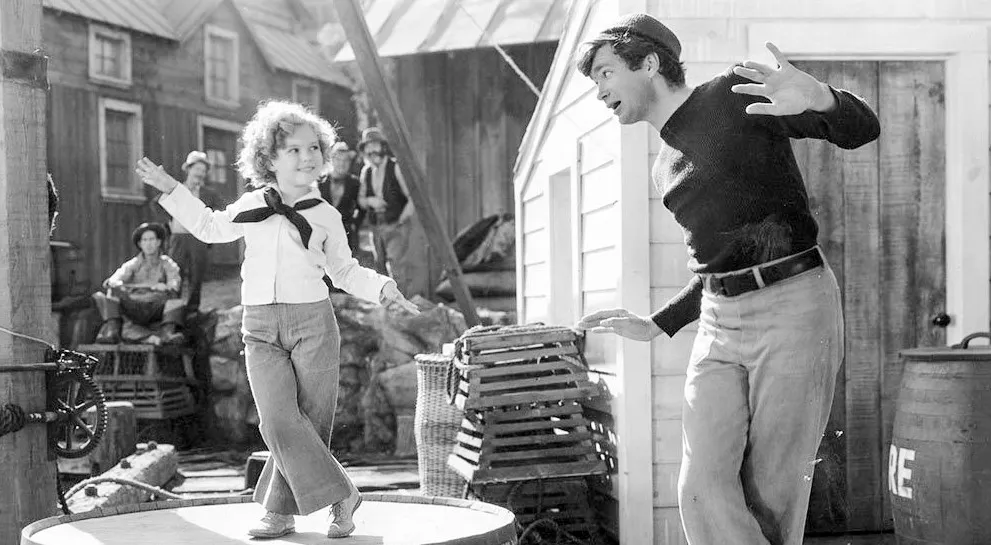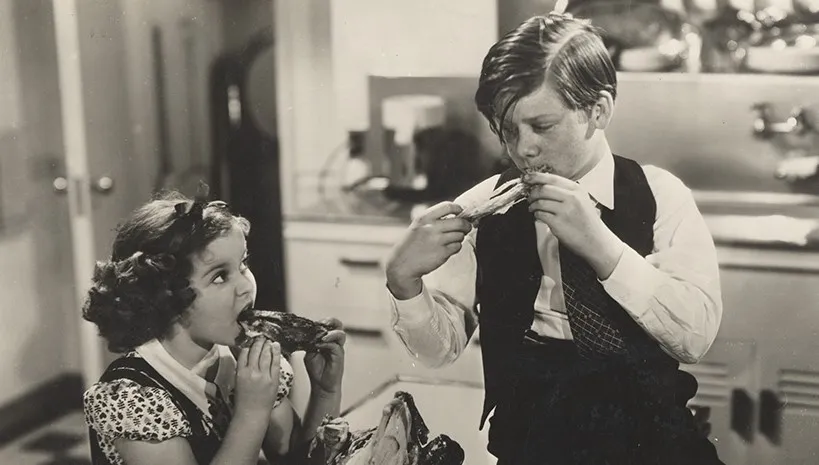Shirley Temple, the most famous child star of the 1930s, had already captivated the hearts of millions by the time she starred in Just Around the Corner in 1938. At the tender age of 10, Temple was already an established icon, known for her infectious charm, irresistible smile, and undeniable talent.
Just Around the Corner, like many of her films, was crafted to lift the spirits of a nation mired in the depths of the Great Depression. This film, while often considered a classic example of her work, also carries a deeper significance as it reflects the hopes and dreams of the era.
Shirley Temple: America's Little Darling

By 1938, Shirley Temple was a household name. Born in 1928, she had begun her career at the age of three and quickly rose to prominence with films such as Bright Eyes (1934) and Curly Top (1935).
Her precocious talent, combined with her delightful personality, made her a symbol of hope during a time when the United States was struggling economically.

Temple's films were often lighthearted, offering a sense of escapism for audiences facing harsh realities. She became synonymous with positivity and resilience, characteristics that endeared her to people of all ages.
Just Around the Corner was no exception to this trend, and it showcased Temple in a role that emphasized her ability to bring joy to even the most difficult circumstances.
Just Around the Corner: Plot Overview

Just Around the Corner is a musical comedy that tells the story of Penny Hale, played by Shirley Temple.
Penny is the daughter of Jeff Hale (played by Charles Farrell), an architect who falls on hard times during the Great Depression.
After losing his job, Jeff and Penny are forced to move into a modest apartment, a far cry from their previous comfortable lifestyle.

Despite their financial struggles, Penny remains optimistic and determined to help her father find success again.
She befriends Milton Ramsby, a wealthy and influential businessman, and sets out to convince him to give her father a chance at a new project.
Along the way, Penny's unyielding spirit and cheerful disposition win over the hearts of those around her, ultimately leading to a happy resolution where Jeff is given the opportunity to rebuild his career.

The film's title, Just Around the Corner, is a reflection of the message it conveys: that better times are just around the corner, even in the darkest of days.
This theme resonated deeply with Depression-era audiences, who were longing for signs of hope and recovery.
The Role of Music and Dance in the Film

As with many of Shirley Temple's films, music and dance play a central role in Just Around the Corner. The film features several lively musical numbers, showcasing Temple's talents as a singer and dancer.
One of the standout songs is "I Love to Walk in the Rain," a cheerful tune that Penny sings as she skips through the streets during a rainstorm.
The scene captures the essence of Temple's character: a young girl who finds joy and beauty in even the most ordinary moments.

Another memorable number is "This Is a Happy Little Ditty," in which Temple performs a tap dance routine with Bill Robinson, her frequent co-star and one of the most famous tap dancers of the time.
Their on-screen chemistry and seamless dance moves were a hallmark of the films they appeared in together, and Just Around the Corner was no exception.
Robinson, an African American performer, and Temple, a young white girl, formed a groundbreaking partnership that defied racial norms of the era, although the relationship was viewed through the lens of 1930s Hollywood and its limitations.

These musical sequences were not just entertaining; they also reinforced the film's central theme of optimism.
Through song and dance, Temple's character spreads joy and positivity, reminding audiences that happiness can be found even in difficult times.
Social and Cultural Impact

Just Around the Corner was released at a time when the United States was still reeling from the effects of the Great Depression.
Unemployment was high, and many people were struggling to make ends meet. In this context, Temple's films provided a form of escapism that allowed audiences to forget their troubles, even if only for a few hours.

However, Just Around the Corner was more than just a feel-good movie; it also reflected the era's values and aspirations.
The film emphasized the importance of resilience, family, and community—qualities that were essential for survival during the Depression.
Penny's determination to help her father and her unwavering belief that better days were ahead resonated with viewers who were facing their own challenges.

Moreover, the film's portrayal of a strong father-daughter bond and the idea that family could weather any storm together was particularly poignant. In a time when many families were struggling to stay afloat, the Hales' story served as a reminder of the power of love and support.
The film also touched on themes of social class and economic disparity, issues that were at the forefront of national consciousness during the Depression.

Jeff Hale's fall from a successful architect to a man struggling to make ends meet mirrored the experiences of many Americans who had seen their fortunes decline.
Yet, the film's resolution—where hard work, perseverance, and a little bit of luck lead to a better future—offered a hopeful message that resonated with Depression-era audiences.
Shirley Temple's Enduring Legacy

Just Around the Corner is just one example of the many films that contributed to Shirley Temple's lasting legacy.
Her performances during the 1930s not only entertained audiences but also provided comfort and hope during one of the most challenging periods in American history.
Temple's ability to convey optimism and resilience through her characters made her a beloved figure, and her influence extended far beyond the silver screen.

As an adult, Temple continued to be a positive force, transitioning from acting to a successful career in diplomacy and public service.
However, her work as a child star remains a significant part of her legacy, and films like Just Around the Corner continue to be cherished by fans of all ages.

The film itself remains a testament to the power of cinema to uplift and inspire.
While the world has changed significantly since the 1930s, the themes of hope, perseverance, and the belief that better days are just around the corner are timeless.
In this way, Just Around the Corner continues to resonate with audiences today, just as it did when it was first released.

Shirley Temple's performance in Just Around the Corner is a shining example of why she became one of the most beloved figures in Hollywood history.
The film, with its themes of hope and resilience, provided a much-needed boost to Depression-era audiences and remains a classic today.
Through her infectious charm and unwavering optimism, Temple captured the hearts of millions and left an indelible mark on American culture.
Just Around the Corner stands as a testament to the enduring power of hope and the belief that no matter how tough times may be, better days are always just around the corner.
More Publicity Stills

Shirley Temple and Charles Farrell, Just Around The Corner, 1938

Shirley Temple and Amanda Duff, Just Around The Corner, 1938

Shirley Temple in Just Around The Corner, 1938

Shirley Temple and Franklin Pangborn, Just Around The Corner, 1938

Bennie Bartlett and Shirley Temple, Just Around The Corner, 1938

Bennie Bartlett and Shirley Temple, Just Around The Corner, 1938

Shirley Temple and Claude Gillingwater in Just Around The Corner, 1938

Shirley Temple in Just Around The Corner, 1938

Shirley Temple and Bennie Bartlett, Just Around The Corner, 1938

Franklin Pangborn, Bennie Bartlett, and Shirley Temple, Just Around The Corner, 1938

Shirley Temple and Bill Robinson, Just Around The Corner, 1938

Shirley Temple and Charles Farrell, Just Around The Corner, 1938

Shirley Temple and Charles Farrell, Just Around The Corner, 1938

Shirley Temple and Leonard Kibrick in Just Around The Corner, 1938

Claude Gillingwater and Shirley Temple, Just Around The Corner, 1938

Claude Gillingwater and Shirley Temple, Just Around The Corner, 1938

Claude Gillingwater, Shirley Temple, and Charles Farrell in Just Around The Corner, 1938

Shirley Temple in a deleted scene from Just Around The Corner, 1938

Shirley Temple, Just Around The Corner, 1938

Shirley Temple, Just Around The Corner, 1938

Shirley Temple, Just Around The Corner, 1938

Shirley Temple, Just Around The Corner, 1938

Bill Robinson and Shirley Temple, Just Around The Corner, 1938

Bill Robinson and Shirley Temple, Just Around The Corner, 1938

Bill Robinson and Shirley Temple, Just Around The Corner, 1938

Franklin Pangborn, Claude Gillingwater, Shirley Temple, Charles Farrell, and Amanda Duff, Just Around The Corner, 1938

Shirley Temple and teacher Frances Klamt being observed by Better Homes and Gardens writer, Gladys Denny Shultz, in Shirley's dressing room trailer during filming of Just Around The Corner, 1938

Shirley Temple and Better Homes and Gardens writer, Gladys Denny Shultz, Just Around The Corner, 1938

Shirley Temple in her dressing room trailer wearing a dress from Just Around The Corner, 1938

Shirley Temple and Ching Ching, Just Around The Corner, 1938

Shirley Temple and Ching Ching, Just Around The Corner, 1938

Shirley Temple, Just Around The Corner, 1938

Shirley Temple Thanksgiving publicity shot, Just Around The Corner, 1938



